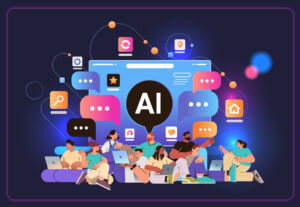How PwC uses AI to personalize its intranet and employee experience
PwC’s Megan DiSciullo on the firm’s journey using its own tech as ‘customer zero’.

While the integration of GenAI tools and platforms into communications workflows is well-documented , many organizations are still collecting data on the outcomes of these newfound, automated efficiencies.
Time saved researching and drafting is time reclaimed for more creative thinking that can elevate the communications function to make a more strategic impact on the business. But alongside business acceleration, you can also enable your workforce to work with GenAI tools that can make their professional lives better.
Megan DiSciullo, communications leader for the US and Mexico at PwC, understands this need firsthand. PwC currently has about 75,000 employees in the US, all of whom are on a different journey with their benefits, learning and development, inclusion commitments and more. When DiSciullo took over the combined internal and external communications teams nearly four years ago, she soon understood that personalizing the employee experience would need to be a priority.
The world was at the height of COVID back then when, along with other societal issues, the communications space found itself in a state of disruption. DiSciullo and her team realized that leaning into technology and data tools could help guide them in this journey.
What began with a push for role-based personalization, where user experiences are delivered based on segmented information like employee level and office location, evolved into interest-based personalization last year as PwC asked employees to self-select their interests from a variety of categories on its intranet.
DiSciullo credits PwC’s Director of Digital Communications, Christina Kravatas, as one of the masterminds behind this project.
“As a woman doing this in tech, she’s sitting on the communications team with a very high technical acumen and able to lead with trust from both the communications and tech space,” said DiSciullo. “This is so important when we look at where communications is going. We need more people like Christina in the profession who can speak the tech and communications language in order to make this work.”
DiSciullo thinks back to a year ago when her team was just starting to think about what generative AI means for the comms function. “The team now is truly actualizing it, and if you look at the crawl, walk, run, we are now firmly walking as part of our workflow,” she said.
Ahead of DiSciullo’s deeper dive at Ragan’s Employee Experience Conference this August, here’s how she worked with Kravatas helped PwC get there, and where this effort is going.
The journey
Internally, PwC was also acting on a growth strategy during the pandemic — 55,000 employees then to 75,000 today.
“The one-size-fits-all all approach didn’t work,” DiSciullo remembered, “especially when your goals are charged with mass communications. We kept hearing from our employees and our partners, ‘We need more personalization from you’. So we started to explore that concept, what it could mean, and the journey we could go on for our 75,000 partners and employees.”
This process began with identifying roles and demographics. PwC started segmenting each employee’s level, what business segment they sit in and where they are based geographically.
When PwC rolled out My+, an initiative focused on tech-enabling its people experience, the firm also discovered that its people were overwhelmed by the vast array of benefits and didn’t know where to start.
“We started to hear formal and informal employee feedback that said, ‘I’m not just my demographics,” DiSciullo recalled.
This led to the next stage of the personalization journey at PwC, messaging tailored to individual interests.
A personalized intranet
Building an option in PwC’s intranet for employees to opt-in was key. In this respect, DiSciullo and the team took the marketing playbook and applied it to internal communications.
“Now our employees have the opportunity to opt in to their interests, whether it’s benefits or inclusion network groups that are going on that they can take advantage of to make it feel more personal.”
A dedicated “My Interests” feature lets employees check boxes that fall under multiple categories that are important to them, personally. Well-being includes preferences for financial, physical, spiritual, emotional, mental and social well-being, along with one-to-one coaching and well-being committees. Other sections include total rewards and benefits, learning and development, purpose and inclusion (which includes networks, internship programs, volunteering programs), and more.
Checking these boxes generates each employee’s “My News” feed on the intranet homepage where their individually personalized news is displayed alongside the firm’s top news and the employee’s role-based demographic news.
“We’re in Business Services, but it also shows our segments: Consulting Solutions, Trust Solutions–all personalized to your business segment,” DiSciullo pointed out. “Then you get down to personalized news which is what you have opted into.”
As a future step, DiSciullo, Kravatas and the team are further taking a page from the marketing playbook by focusing on behaviors based on these interactions. Just as you’d see programmatic ads when browsing online for an outfit, relevant PwC content will be served to employees based on what they click on.
The push and the pull
DiSciullo and her team think of PwC’s intranet customization as “the pull” in a push and pull paradigm. Its newsletters are the “push”.
While PwC pushes out newsletters on a firm-wide basis based on segment and geography, the firm also recently incorporated the personalized “My News” feed from the intranet directly into the firmwide newsletter, creating a personalized section that’s unique to its 75k recipients.
“In addition to getting your top news that the firm feels you need to know to do your job, every other Friday you get news dedicated right to you, customized to each individual,” DiSciullo said.
This strategy is starting to gain traction. The open rate for the newsletters is consistently in the 60-70% range. After bringing the option for personalized news into the firmwide newsletter more readers subscribed to interests and the overall intranet news page views increased the following month.
“The feedback we’ve gotten from employees so far is super positive,” DiSciullo said. “It’s that you’re meeting me where I want to be met and making something very large feel small again.”
AI lessons learned as client zero
Throughout this journey, PwC learned that its business is so diverse that the information each individual needs to do their job looks very different—as does the information you care about within the firm.
Working from a north star of hyper-personalization took a minute, but the steps that PwC took are proving successful so far.
“AI is just the supercharger within this mass personalization, allowing us to do it faster, at scale with more accuracy and quality,” DiSciullo said. Leaning into GenAI lets them identify a core message, then customize it to various segments in a way that’s not as expensive or time-intensive while still producing quality outputs.
DiSciullo is grateful that the communications team has a couple of PwC proprietary AI tools in its arsenal — including a content generator that helps them customize content to all of the aforementioned population types, not only in message but in tone.
“How you’re speaking based on what the information is, and who you’re speaking to, matters,” DiSciullo said. “In some cases you want a more formal tone or a more casual tone. Our AI tool helps to generate content, allowing us to not only create the content, but do it in the tone and voice that we want to speak to our people or audience with at a certain time.”
PwC put a $1 billion investment into GenAI last year and considers its internal audiences across the firm the pilot participants for this too. “Our people across the firm are client zero, and we are client zero for communications. If you’re using a consumer tool, stop,” DiSciullo said. “You need to be using a secure AI tool.”
This is certainly true for firms like PwC which are trusted stewards of confidential information produced in their client work. PwC’s evolving suite of secure tools includes a checker that helps with risk and compliance reviews.
“It doesn’t replace risk and compliance, but it does that initial cut of a review so when it gets to a risk or quality check for a human,” Disciullo said. “They’re dealing with the more complex things, not the more mundane things that the tool can catch.”
Where they’re going
These efforts are all part of a larger, firm-wide learning and development initiative at PwC, dubbed “My AI,” which 75% of the firm has opted into voluntarily.
Getting over the fear that this will take your job allows you to invest in the strategic things you couldn’t do because of bandwidth. “When you get over that, your mindset shifts dramatically,” continued DiSciullo. “It doesn’t change the importance of judgment and oversight. That’s the human element definitely needed in the organization. AI allows us to react and get a head start as opposed to what we’ve always done.”
DiSciullo stresses the importance of this moment of rapid acceleration and growth as an inflection point for communicators to facilitate communal learning and upskilling around using AI.
“Gen AI is one of those once-in-a-generation moments across the profession and across the business community,” she said.
“This democratization of learning rarely happens, when you’re all learning something at the same time. Typically, someone’s done something and they’re teaching newer members of the organization based on their lessons learned or experience. But I’m learning at the same time as senior associates. We are just starting this journey as a firm and as a team, but we are excited for what’s to come.”
Join DiSciullo alongside comms leaders from Cisco, ADP, CVS Health and more at Ragan’s Employee Experience Conference, August 12-14 at Nashville’s Four Seasons.
PwC is a member of Ragan’s Communications Leadership Council.
Justin Joffe is the Editorial Director and Editor-in-Chief at Ragan Communications where he oversees the editorial strategy for Ragan across brands and products.








What intranet platform are they using that allows employees to opt in like this?
To me, that is the heart of this article. But “AI” in the title got my click. In my opinion, they are not using AI any differently than many early adopters, including myself, who already use it. This cool opt-in feature allows the comms team to produce a high volume of content that can now be delivered more relevantly to each of their 75,000 employees.